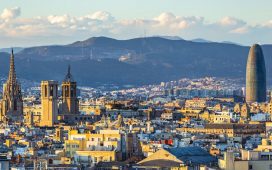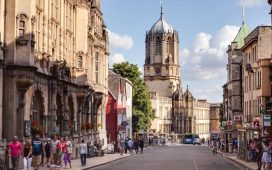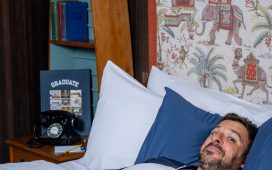It started with a disagreement. Where to go on an early autumn break? I wanted a city and history, my boyfriend wanted coast and stunning scenery. The solution? Two days in the Serbian capital Belgrade, a train ride to Montenegro, and some time on the Adriatic. In the end, the cinematic train journey proved the real star of the show.
Belgrade is an eclectic mix of Habsburg, Ottoman and brutalist architecture with a buzzy nightlife. At the Museum of Yugoslavia we learn that the Belgrade to Montenegro train was one of former communist president-dictator Tito’s proudest projects. The line opened to great fanfare in 1976, after Yugoslavian engineers had spent 20 years burrowing through mountains to reach the Adriatic, carving out 254 tunnels and 435 bridges.
Tito had his own private train attached to the tracks days before the official opening so he could enjoy a coastal holiday away from the hot government headquarters in Serbia. Its faded blue carriages can still be seen in Topcčider park and the museum among other communist paraphernalia.
That first 300-mile journey took seven hours and stopped at over more than 50 towns. It was a beautiful route, but the glory was short-lived. In the 1990s, Yugoslavia fell apart in a bloodbath. Parts of the railway line were bombed and the link to the coast ceased to exist. Then, in 2016, the line was revived, in a joint effort between Serbia and Montenegro, a rare instance of cross-border infrastructure revival post-Balkan wars.
At first, it had a few teething problems: several breakdowns due to rickety worn rails, tedious border crossings through countries that no longer see eye-to-eye. But slowly things got back on track. Old sleeper carriages were replaced with comfier models. Now, the 11-hour journey is one of the most scenic routes in Europe (and you can stop off and explore the region further en route).
After leaving a sun-drenched Belgrade behind, it’s not long before we’re gazing out at the rolling hills of the verdant Valjevo and Užice wine regions. The scenery starts becomes more dramatic as the line reaches the Zlatibor mountain range. We’re tempted to get off and explore Tara national park, which has excellent hiking trails and wild camping spots. But we press on, gathering speed past well tended fields and roaming goats.
We pass through a slice of Bosnia-Herzegovina and back into Serbia again. In 1976, there were no border checks between these Yugoslav republics. Today, stern border guards rap on the carriage door at each crossing and hawkers board the train and sell beer, burek (pastries) and cigarettes.
After our third border crossing, the pastoral hills swell into Montenegro’s Black Mountains, which dodge in and out of view between the tunnels and bridges. At Kolašin, a town near Durmitor national park, we stop to stretch our legs and peer up at monasteries atop impossible summits. How fun it would be to climb them. Next time, we think, as the long hoot of the train’s whistle signals our departure.
Within an hour we reach the dizzying Mala Rijeka viaduct. Our train briefly resembles the Hogwarts Express soaring over the Scotland’s Glenfinnan viaduct in the Harry Potter films. After that, the mountains taper to the brutalist blocks of Montenegro’s capital Podgorica – named Titograd from 1946 until 1992. There’s little to recommend it, so we keep going to Virpazar on Lake Skadar, where we stop and spend a day pottering in a boat.
after newsletter promotion
Photograph: Alexander Nikiforov/Alamy
Half of the lake falls within Albania’s borders, and the Accursed mountains double up in the reflection of the water. These days the main division is a culinary one: Albania prepares the lake’s carp in a sizzling prune and tomato sauce called tavaë krapi, and Montenegro eats the freshwater fish salted and pickled, which is best tasted right by the water at the Restaurant Silistria.
The next afternoon, we’re back on the train for the last stretch. At sunset, the Adriatic hoves into view. The sea opens to one side, the oranges and pinks in the sky melting into the water. For the final hour we swing past craggy headlands and sand-swept bays, arriving in Bar as darkness falls.
New Bar is a collection of communist-era blocks, but just visible on the hilltop is the old town and fortress surrounded by ancient olive groves and pomegranate trees. After an evening sea dip at Šušanjska beach (the water is warm long into October), we hike up to Bar old town. The rambling streets boast palazzo-style manor houses, built when this coast was under the Venetian empire. Cafes such as Velja Vrata serve a refreshing local speciality, pomegranate wine. We take a bottle of this the next day on our scramble along the coast to the beautifully secluded beach at Ratac, near a ruined Catholic monastery.
A few old houses in Bar have been restored. One – Stara Čaršija boutique hotel – shows all the influences layered on to this region. It’s part-Venetian patrician house, part-Montenegrin stone kula tower, part-Ottoman hammam and we head to the spa for some pampering.
Later in life, Tito suffered diabetes and an arterial embolism in his left leg, and came to Montenegro for health reasons. He died at a medical centre in Ljubljana in 1980, four years after the public train opening, but the sea air and stints at coastal sanatoriums must have soothed his illnesses. After Bar, he’d head further up the coast to Kotor Bay, fabled to have healing effects because of its clean air. Tito’s favourite sanatorium, Igalo, near picturesque Herzceg Novi, is still a wellness centre practising sea mud treatment. Across the bay, the newly opened Hyatt is also a curing hotel with a medical centre.
After a morning hiking the Vrmac mountain trail, we hit the beach at Plavi Horizonti Plaža for the last day; a perfect way to end a trip that has covered hundreds of miles, seen us absorb a huge amount of history and architecture, and taken in both mountains and sea. Both of us were happy.
Prices start at €21 for train trip from Belgrade to Bar. Tickets can be bought at Belgrade, Podgorica and Bar stations; they are not available online. For more details see Man in Seat 61. Car hire was provided in Montenegro by Montenegro national tourism organisation and Bar’s local tourism organisation













